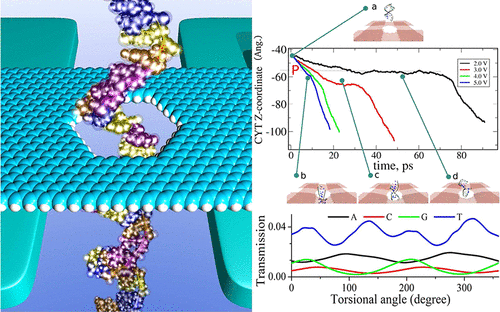Graphene layers have been targeted in the last years as excellent host materials for sensing a remarkable variety of gases and molecules. Such sensing abilities can also benefit other important scientific fields such as medicine and biology. This has automatically led scientists to probe graphene as a potential platform for sequencing DNA strands. In this work, we use robust numerical tools to model the dynamic and electronic properties of molecular sensor devices composed of a graphene nanopore through which DNA molecules are driven by external electric fields. We performed molecular dynamic simulations to determine the relation between the intensity of the electric field and the translocation time spent by the DNA to pass through the pore. Our results reveal that one can have extra control on the DNA passage when four additional graphene layers are deposited on the top of the main graphene platform containing the pore in a 2 x 2 grid arrangement. In addition to the dynamic analysis, we carried electronic transport calculations on realistic pore structures with diameters reaching nanometer scales. The transmission obtained along the graphene sensor at the Fermi level is affected by the presence of the DNA. However, it is rather hard to distinguish the respective nucleobases. This scenario can be significantly altered when the transport is conducted away from the Fermi level of the graphene platform. Under an energy shift, we observed that the graphene pore manifests selectiveness toward DNA nucleobases.

Graphene layers have been targeted in the last years as excellent host materials for sensing a remarkable variety of gases and molecules. Such sensing abilities can also benefit other important scientific fields such as medicine and biology. This has automatically led scientists to probe graphene as a potential platform for sequencing DNA strands. In this work, we use robust numerical tools to model the dynamic and electronic properties of molecular sensor devices composed of a graphene nanopore through which DNA molecules are driven by external electric fields. We performed molecular dynamic simulations to determine the relation between the intensity of the electric field and the translocation time spent by the DNA to pass through the pore. Our results reveal that one can have extra control on the DNA passage when four additional graphene layers are deposited on the top of the main graphene platform containing the pore in a 2 x 2 grid arrangement. In addition to the dynamic analysis, we carried electronic transport calculations on realistic pore structures with diameters reaching nanometer scales. The transmission obtained along the graphene sensor at the Fermi level is affected by the presence of the DNA. However, it is rather hard to distinguish the respective nucleobases. This scenario can be significantly altered when the transport is conducted away from the Fermi level of the graphene platform. Under an energy shift, we observed that the graphene pore manifests selectiveness toward DNA nucleobases.
